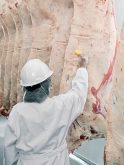Grain-based diets improve feed efficiency, but increase the risk of rumen acidosis. Rumen acidosis occurs when rumen pH drops below 5.6 for more than three consecutive hours. Severe or chronic acidosis is an animal welfare concern due to rumen damage, liver abscesses, lameness, and an economic cost due to compromised feed conversion and growth performance. Consequently, feedlot operators manage their feed bunks and feeding programs very carefully, particularly as cattle transition from forage-based backgrounding to grain-based finishing diets.
The risk of acidosis is influenced by grain type (wheat being a higher risk than corn, with barley being intermediate), the extent of grain processing, feeding frequency and bunk management. Group size and pen density are also factors, so research trials using individually fed animals may produce different results than trials where cattle are fed in larger groups.
Read Also

Body condition, nutrition and vaccination for brood cows
One of the remarkable events of the past century related to ranching has been the genetic evolution of brood cows….
Brittany Wiese, Greg Penner and co-workers at the University of Saskatchewan recently published the results of a trial partly funded by the Beef Cattle Research Council in which backgrounded cattle were transitioned to a wheat-based finishing diet at a commercial feedlot in southern Alberta (Defining risk for low reticuloruminal pH during the diet transition period in a commercial feedlot in western Canada J. Anim. Sci. 95:420).
What they did: A total of 998 crossbred yearling heifers and 907 steers were fed separately in eight pens averaging 249 heifers or 227 steers per pen. In each pen, four cattle were given a bolus to continuously measure and record rumen pH. Cattle were initially fed a backgrounding diet for 66 days (46.5 per cent corn and alfalfa silage, 38 per cent barley grain, 15 per cent DDGS, limestone, and mineral and vitamin premix), then stepped up over 40 days and five transition diets to a finishing diet (9.5 per cent corn silage, 80 per cent wheat grain, 10 per cent DDGS, and mineral and vitamin premix). Cattle were fed three to four times per day, such that bunks were “slick” (completely empty) at the end of the day. On days when the diet changed, the new diet was introduced at the second feeding of the day. Straw bales were added to the pen once when staff felt that cattle were experiencing digestive upsets. The boluses and pH data were recovered when the cattle were slaughtered at the end of the feeding period.
What they learned: As expected, increasing the level of wheat grain in the diet had the expected effects on rumen pH. In all cattle, pH dropped, became more variable, and pH spent more time below 5.6 as the cattle moved through the transition diets. On the first transition diet, pH averaged 6.4, cattle averaged 10 minutes per day at a pH below 5.6, and fewer than 10 per cent of cattle experienced between one and three bouts of acidosis (i.e. episodes where they spent 180 consecutive minutes below pH 5.6). On the finishing diet, pH averaged 6.1 and cattle spent an average of 157 minutes per day at a pH below 5.6. Over 40 per cent of cattle experienced one to three bouts of acidosis, and less than 10 per cent experienced seven to ten bouts of acidosis. Some cattle had bouts of acidosis on more than one diet; when added across the whole trial, 57 per cent of cattle had experienced one to three bouts, 20 per cent had experienced four to six bouts, three per cent had experienced seven to 10 bouts, and three per cent had experienced more than 10 bouts of acidosis.
What it means: Three things stand out for me. Cattle can be successfully transitioned to a wheat-based finishing diet with pH effects of a relatively mild severity, provided it’s done carefully and slowly. By comparison, an earlier trial (J. Anim. Sci. 92:3053) adjusted cattle (35 head per pen) from 42 per cent to 81 per cent barley grain using four transition diets over 19 days with similar results; on the final diet, pH averaged 6.0, with cattle spending up to 195 minutes per day at pH below 5.6.
Another study where cattle were penned and fed individually as they were transitioned from 35 per cent to 85 per cent barley grain in five steps over 15 days reported an average pH of 5.8 with cattle spending more than nine hours per day at pH below 5.6 (J. Anim. Sci. 83:1116). This confirms that rumen pH measurements collected from individually fed cattle do not represent those experienced by cattle in pen feeding situations.
Cattle evidently vary considerably in their ability to cope with high-grain diets. Although 26 per cent of cattle in this study experienced four or more bouts of acidosis during this trial, 57 per cent experienced only one to three bouts, and 17 per cent experienced no acidosis at all. More research would be needed to determine whether these differences stem from their place in the pecking order, genetic differences, differences in the bacteria, protozoa and fungi in their rumen (i.e. the “rumen microbiome”), previous nutritional and health history, or some combination of all these things.
The Beef Research Cluster is funded by the Canadian Beef Cattle Checkoff and Agriculture and Agri-Food Canada with additional contributions from provincial beef industry groups and governments to advance research and technology transfer supporting the Canadian beef industry’s vision to be recognized as a preferred supplier of healthy, high-quality beef, cattle and genetics.

















